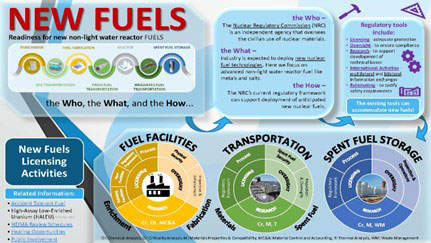Traditional light-water reactor (LWR) fuel consists of uranium oxide fuel pellets enriched up to 5 weight percent uranium-235 (U-235), within an array of zirconium-based cladding. The nuclear industry is designing reactor fuels with operational conditions that differ significantly from traditional LWR fuels in that they may take different forms and include new materials. We recognize that there are considerations for these new fuel technologies across the entire nuclear fuel cycle, including enrichment, fuel fabrication, transportation, in-reactor requirements, reprocessing and spent fuel storage and disposal.
The NRC licenses and regulates the Nation's civilian use of radioactive materials to provide reasonable assurance of adequate protection of public health and safety and to promote the common defense and security and to protect the environment. The NRC considers public involvement in, and information about, our activities to be a cornerstone of strong, fair regulation of the nuclear industry.
The NRC can review and regulate near-term uses of these fuel designs, including review of applications with the current regulatory framework. The Infographic below shows the regulatory tools we have in place to oversee an advanced fuel cycle. These tools include licensing, oversight, rulemaking, and research. The infographic is interactive with links to the relevant programmatic areas.

Contact Us
Note: Before corresponding with us, please see our Privacy Policy regarding Public Disclosure of Submitted Information.
If you have a comment or question you may email NewFuels.Resource@nrc.gov.
If you have more generic comments or questions, please go to the NRC Contact Us page.
Page Last Reviewed/Updated Friday, July 07, 2023